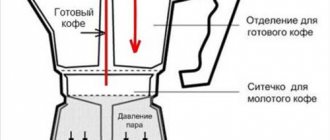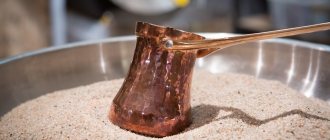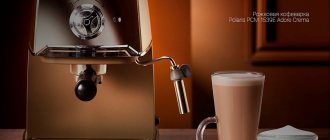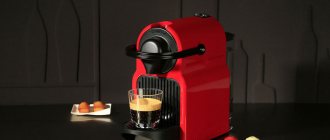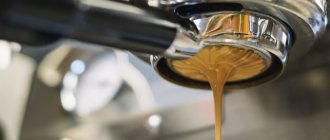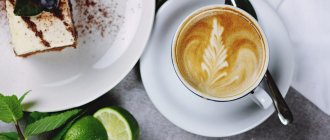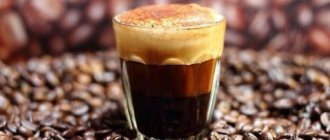Pourover, Hario, v60 - these are all names for the same method of making coffee. Pour over comes from the English pour over, literally translated as pouring from above. Hario - after the name of the Japanese company that produces accessories for this method. V60 - because the dripper funnel looks like the Latin letter V, and the angle between its walls is 60°.
The method became popular only in 2010, after the publication of an article about it in The New York Times, and was invented almost a hundred years before that. Preparing a pour-over is a real ritual, which is called a “coffee ceremony,” however, this ritual can be mastered quite easily, and its result will be unmistakably delicious.
Life hack: The Hario pourover, like the AeroPress, is very compact. Take it on the go and make crazy coffee wherever you are!
Enjoy your coffee!
And remember that there is always room for experimentation - try different grains, change the grind size, change the water temperature, or try putting a couple of ice cubes or frozen fruit slices in a cup, this will give the drink a special sweetness. Try an alternative recipe called Pour Over Coffee. Making coffee in the Hario V60 is similar to any other pour-over machine, such as a Chemex or Drip coffee maker, you will find their recipes in our articles.
Varieties of pour over
There are several types of pourovers:
- Classic funnel Hario V60. Outwardly it resembles a coffee cup with a handle and a hole in the bottom. The designation V indicates the shape of the device, and 60 indicates the angle at which the walls tilt towards the bottom. To prevent the filter from sticking to the inside of the dripper, the product is equipped with convex longitudinal ribs.
- Kalita Wave. Instead of one large hole, 3 small ones are made in the product. The ribs are placed horizontally. Special pleated filters are included with the funnel. The taste of the drink in this pour-over is more intense and the aromatization is stronger. The disadvantage is the high cost of the product.
- The December Coffee Dripper. Invented by Nicholas Cho. There are 12 small holes at the bottom. Thanks to the rotating base, it is possible to open and close holes and control the flow rate of the prepared extract.
- Clever Dripper. Thanks to the presence of a valve, coffee can be steeped by opening the device at the required period of time.
The Hario V60 resembles a coffee cup with a handle.
Other methods of brewing coffee
Among the alternative methods of preparing coffee, many are similar in principle to pour over:
- Chemex. Externally it looks like a glass vase or an hourglass. At the narrowest point it is often fastened with a leather strip. Consists of a funnel equipped with a filter, a flask with a spout. The aroma of the drink is weaker than when using a pour-over. The disadvantages are fragility and high cost. The advantage is the original appearance, thanks to which the accessory is often used as a piece of furniture.
- Percolator. The liquid passes through the filter for 10 minutes and is boiled several times. This results in very bitter, low quality coffee.
- Vietnamese filter. Used to make delicious iced coffee. The powder is poured with heated water and then waited for 5 minutes. Ice is often added to the finished drink.
- Cold brew. Coffee takes more than 10 hours to prepare. When prepared by cold filtration through crushed grain, bitterness and sourness almost disappear. At the same time, the aroma turns out to be rich and rich.
Choosing a coffee type for pour over
Experienced baristas advise giving preference to freshly roasted single-origin Arabica beans. Avoid using mixes with robusta, as even a small amount will make the drink bitter. It is better to take a medium roast or lighter grain. The darker one is not suitable. Flavored grains are not recommended. It’s better to experiment with varieties, brew different ones, and choose the one that’s more suitable for yourself.
Give preference to roasted Arabica beans.
Selection of items and accessories
The necessary accessories can be purchased at coffee shops.
Funnel
When choosing a dripper, consider the material, shape, grooves, and ribs. Plastic products are cheap and light, but do not retain heat well. They are often purchased as trial material to evaluate the method. Metal, durable, easy to use. Glass ones allow you to observe the process and retain heat well.
Their disadvantage is considered fragility. Ceramic ones have low thermal conductivity, which has a positive effect on aromatization.
Hot water kettle
You will need a special kettle-hario. This is a metal container with a curved spout located above the bottom. There are electric varieties, less expensive products for heating on a burner. Since you will have to hold the utensils in your hands, choose a product whose handle is covered with thermal insulation material. If a special teapot is not available, a simple teapot can be used. Such dishes are less convenient because liquid can flow through its spout too quickly.
A hot water kettle is a container with a curved spout.
Filters
In stores you can find:
- Disposable multilayer paper sizes 0.1, 0.2, 0.3. They will need to be wetted before use. Otherwise, the drink will taste like paper. After use, the product is immediately thrown away and cannot be reused.
- Fabric. Reusable devices secured with a holder.
- Reusable metal. Choose products from the same company that produces drippers.
Clock (stopwatch)
Any stopwatch is suitable for measuring time. Use the built-in program on your mobile phone or tablet so you don't have to buy a separate device.
Container for ready-made coffee
Choose any container that retains heat for a long time. Glass glasses and ceramic mugs are suitable. Porcelain cups may be used. The best choice is a glass pitcher with a spout and measuring marks, also called a serving kettle. This will make it easier for you to keep track of the amount of drink poured.
For ready-made coffee, choose ceramic mugs.
Electronic balance
You will need scales with increments of 0.1 g. The device must show the weight of the crushed grain as accurately as possible so that it is possible to determine the required amount of liquid.
Bay, pre-extraction or "bloom"
Pre-extraction or “blooming” is the preliminary wetting of the grind with water. This is how extraction starts in the coffee and carbon dioxide escapes. If the gas is not released, the water will not pass through the coffee granules and the coffee will not get its taste and will be watery.
Turn on the stopwatch on your phone and pour water in a thin stream in a spiral from the center to the edges:
You can even help yourself, like Will from Tested, by making a special dimple in the center:
Will from Tested pours
But Paul from Elemental pours coffee from the edges to the center. This is a deadly number! Don't repeat after him. At least until you make your first dozen pour-overs and understand the process from start to finish.
Elemental floor is flooded
Coffee baristas have an unspoken rule: touching the grind during preparation is prohibited. This is not entirely true, but rather a tradition that no one dares to question.
Life hack from Scott Rao . He has spent dozens of hours in the laboratory with a refractometer in his hands and understands the chemistry of the process inside and out. Scott boldly violates the main prohibition of all baristas: “don’t touch the grind.” Repeat after him in the “blooming” step - use a spoon. The idea is to wet absolutely all the coffee in the funnel as quickly as possible and start “blooming” as quickly as possible.
Scott Rao kneads with a spoon
Please note: Scott does not immerse the spoon deeply.
Topping up
Add water 40 seconds after flowering begins. During this time, most of the carbon dioxide will come out of the coffee, and the water will flow freely and take all the best stuff with it.
Pour water in slow circular movements until the total volume is 150 ml. Try to fill dark areas with coffee grounds.
Andrea Pan tops up
Don't overdo it with topping. Keep an eye on the water level. Otherwise:
Unsuccessful topping up
Recipes
Preparation methods differ in taste, amount of coffee and water, ratio of varieties, and type of grinding. The classic cooking principle includes the following steps:
- Assemble the structure: install the device on a large mug or teapot, insert the filter.
- Pour 100-120 ml of water into the filter, dishes, and drain all the liquid.
- Add ground coffee.
- Moisten the surface with coffee (2 ml of water - 1 g).
- Wait 25-35 seconds.
- Pour in a thin stream for 90-120 seconds.
Consumption: 9-10 g of coffee per 100-110 ml of water (temperature 94-96⁰C). If the flow is fast or slow, you can adjust the grinding (take fine or medium).
Instructions for making coffee in a pour-over
To get delicious, aromatic coffee, consider a number of nuances when preparing it.
Grinding degree
When choosing a grind, give preference to medium or coarse. When using paper filters, a fineness level of less than average is suitable. The taste of the coffee will be more intense. Fine grinding is not recommended as grain particles will clog the filter. The coarser the grind, the stronger the sourness in the finished drink.
Water temperature
The liquid should be heated to +92… +96°C. Experienced coffee lovers claim that even a slight deviation from this range can ruin the drink, so it is recommended to use a thermometer. Tap water negatively affects taste.
It is better to use distilled liquid. Mineralization should remain between 70 and 200 mg/l. It is better to use 150 mg/l than others.
Dosage
The ratio of ground beans to water should be 1:10. This recommendation, however, is often violated due to the high strength of the resulting coffee. Coffee lovers select the appropriate dosage individually, starting with 60 g of grain to 1 liter of water.
The dosage of coffee is selected individually.
Distribution of coffee in a paper filter
First, the filter is doused with boiling water. This makes it easier to install the accessory into the funnel and prevents the appearance of a papery taste. Then the device is placed on the scale, the value is reset, and coffee powder is added. The dripper is shaken lightly so that the grain is distributed evenly and lies more densely.
Pre-wetting
At this stage, the remaining air between them is removed from the crushed grains. To do this, water heated to 96°C is poured over the raw material, the mass of which is 3 times the weight of the powder.
After 45–60 seconds, the liquid that has passed through the filter is drained, after which it proceeds to the next stage.
Infusion of water
The longest cooking stage. The liquid will need to be poured slowly over 2–2.5 minutes for one serving of the drink. First, the water should enter the center of the funnel. Then you need to carefully pour it on the sides, moving clockwise. When cooking several portions at once, it is better to repeat the procedure 2-3 times. The layer of liquid should not rise above the grain by more than 2 cm. The next portion is allowed to be poured after the previous one has seeped through the filter.
Grade
Do not throw away the filter immediately. Instead, place the funnel on an empty glass or in the kitchen sink and let the remaining liquid drain out.
When the slurry is gone, you can see from the “tablet” from the coffee grounds how correctly you prepared the pour-over. If the “tablet” looks flat, there are no holes or hills in it - you did everything right.
Scott Rao's Proper Coffee Pill
How to choose
Before purchasing, you should pay attention to the characteristics and decide on the categories:
- size: for 1-2 servings (01), for 4 pieces (02);
- material: plastic, ceramics, glass, metal;
- the presence of a side arch that does not heat up;
- type of filters (disposable, reusable);
- select the equipment (presence of a jug, kettle);
- choose a convenient type of delivery and payment.
A prerequisite is to find out the cost of filters and availability in online stores.

